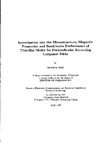Investigation into the Microstructure, Magnetic Properties and Read/write Performance of Thin-film Media for Perpendicular Recording Computer Disks
| dc.contributor.author | PAN, GENHUA | |
| dc.contributor.other | School of Engineering, Computing and Mathematics | en_US |
| dc.date.accessioned | 2013-10-25T08:55:26Z | |
| dc.date.available | 2013-10-25T08:55:26Z | |
| dc.date.issued | 1993 | |
| dc.identifier | NOT AVAILABLE | en_US |
| dc.identifier.uri | http://hdl.handle.net/10026.1/2363 | |
| dc.description.abstract |
Pronounced effect of under layers on the squareness and slope T of the perpendicular loops of very thin CoCr films was observed. Experimental and theoretical studies suggest that, depending on the film microstructure, there are two origins on the anomalous shearing of perpendicular loops of Cc-based perpendicular films: the columnar shape anisotropy and the wall-motion-like magnetization reversal process. For films with larger intercolumnar separation, the contribution of the columnar shape anisotropy to the total demagnetizing factor is mainly responsible for the deshearing of the loops. For continuous perpendicular films, the intergranular exchange coupling controls the magnetization reversal process and the wall-motion-like reversal explains the anomalous shearing of the hysteresis loop. The square and desheared perpendicular loops of very thin CoCr films originated from their strong perpendicular anisotropy and large intergranular nonmagnetic separation. Study of the orientation relationship between the Co-based films and their underlayers suggested that the texture of the very thin CoCr and CoCrTa films is determined by the thermodynamic nature of hcp Co crystal itself and the nature of the underlayers or substrates on which it grows. Amorphous underlayers provide "neutral" substrate surfaces for. the [0002] self-oriented growth of hcp Co-based films. Hcp Ti and [111] textural fee Pt, Au underlayers favour the [0002] oriented epitaxial growth. [100] or [110] textural bee Cr underlayers favour the [1010] oriented growth. The perpendicular coercivity of a Co-based medium is determined by its crystalline anisotropy and intergranular exchange coupling, and can be largely affected by the morphology of its underlayers. The larger perpendicular coercivity of the CoCrTa films on Ti underlayers was mainly due to the large grain diameter which results in a reduction in the intergranular exchange coupling constant. The difference between the surface and bulk coercivity of the CoCrTa films on Ti underlayers was attributed to the improvement of the crystallographic orientation of the hcp Co crystals and the development of large grains as the film grows thicker, which causes the reduction in the surface intergranular exchange coupling due to large grains as well as large intergranular separation. Co84Nb12Fe4 amorphous films were investigated as back-layers for double layer media. Very low coercivity down to 0.0125 Oe was achieved for films of 10000 Å-thick with a saturation magnetic induction of 11 kG. The thickness dependence of coercivity follows the Neel formula for films thicker than 400 Å. A D5o density of 160 KFRPI was achieved for the 2000 Å-thick medium on Pt underlayers using MIG heads of gap length 0.15 µm. Experimental and theoretical analyses of the read/write processes show both the achieved D5o density and the reproduced output level for these media were head field and head-medium spacing limited. Lower medium noise and higher SNR were achieved by the media with Ti underlayers, which supports the intergranular exchange coupling noise theory. | en_US |
| dc.description.sponsorship | Pilkington Group Research, Pilkington PLC, Pilkington Technology Centre | en_US |
| dc.language.iso | en | en_US |
| dc.publisher | University of Plymouth | en_US |
| dc.title | Investigation into the Microstructure, Magnetic Properties and Read/write Performance of Thin-film Media for Perpendicular Recording Computer Disks | en_US |
| dc.type | Thesis | |
| dc.identifier.doi | http://dx.doi.org/10.24382/3655 | |
| dc.identifier.doi | http://dx.doi.org/10.24382/3655 |
Files in this item
This item appears in the following Collection(s)
-
01 Research Theses Main Collection
Research Theses Main


